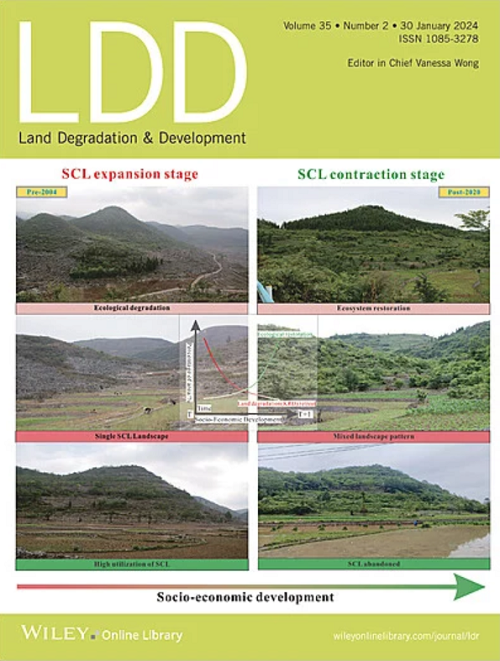Divergent Responses of Microbial Diversity and Extracellular Enzymatic Activities to Straw Addition in Reclaiming Salt‐Affected Soil
IF 3.6
2区 农林科学
Q2 ENVIRONMENTAL SCIENCES
引用次数: 0
Abstract
Soil salinization threatens food security and ecosystem functions, particularly in arid and semi‐arid regions. Besides degrading soil structure and nutrient availability, salinization also disrupts microbial functionality. Although irrigation and organic amendments are widely used to alleviate salinity, their combined effects on microbial diversity and nutrient metabolism remain unclear. Through a 120‐day microcosm experiment, the results demonstrated that intermittent leaching (320.0 mm) significantly reduced soil saltness by 29.3%–36.9% (盐渍土复垦中微生物多样性和胞外酶活性对秸秆添加的差异响应
土壤盐渍化威胁着粮食安全和生态系统功能,特别是在干旱和半干旱地区。除了破坏土壤结构和养分有效性,盐碱化也破坏微生物的功能。虽然灌溉和有机改良剂被广泛用于缓解盐渍化,但它们对微生物多样性和养分代谢的综合影响尚不清楚。通过120天的微观实验,结果表明,间歇淋滤(320.0 mm)显著降低土壤盐分29.3% ~ 36.9% (p <;0.05)。虽然添加秸秆(6.5 t/ hm2)没有直接降低盐含量,但提高了7.6%的浸出效率(p >;0.05)。秸秆和淋滤均能降低硝态氮含量(p <;0.05)。秸秆添加导致优势类群的不成比例生长,减少了微生物多样性,降低浸出条件下的盐度部分缓解了真菌多样性的减少。秸秆添加也显著提高了β -葡萄糖苷酶和N -乙酰氨基葡萄糖苷酶的活性,分别提高了94.6% ~ 161.2%和187.3% ~ 210.9% (p <;0.05),而β -纤维素苷酶、亮氨酸氨基肽酶和碱性磷酸酶的活性未受影响(p >;0.05)。生态酶载体分析表明,载体长度普遍小于0.3,秸秆使载体长度增加44.9% ~ 64.4%。浸出通过减轻盐度胁迫间接降低微生物碳限制(p <;0.05)。土壤主要是氮受限的(矢量角<;55°),秸秆添加和浸出通过真菌多样性产生间接影响。这些发现表明,提出的载体长度阈值0.61可能低估了极端条件下土壤微生物碳的限制,如盐影响土壤。考虑到秸秆添加提高了盐淋效率和养分代谢,优化灌溉与有机改良剂相结合可能是盐渍土壤复垦的有效策略。
本文章由计算机程序翻译,如有差异,请以英文原文为准。
求助全文
约1分钟内获得全文
求助全文
来源期刊

Land Degradation & Development
农林科学-环境科学
CiteScore
7.70
自引率
8.50%
发文量
379
审稿时长
5.5 months
期刊介绍:
Land Degradation & Development is an international journal which seeks to promote rational study of the recognition, monitoring, control and rehabilitation of degradation in terrestrial environments. The journal focuses on:
- what land degradation is;
- what causes land degradation;
- the impacts of land degradation
- the scale of land degradation;
- the history, current status or future trends of land degradation;
- avoidance, mitigation and control of land degradation;
- remedial actions to rehabilitate or restore degraded land;
- sustainable land management.
 求助内容:
求助内容: 应助结果提醒方式:
应助结果提醒方式:


